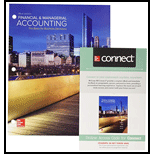
Compute the missing data for Companies X, Y and Z.
Answer to Problem 12E
The missing data for Companies X, Y and Z are as follows:
| Particulars | Company X | Company Y | Company Z | |
| Operating income | $220,000 | e. $1,200,000 | i. $4,800,000 | |
| Sales | a. $687,500 | f. $3,000,000 | j. $9,600,000 | |
| Invested capital | b. $3,437,500 | $6,000,000 | $32,000,000 | |
| Return on sales | 32% | 40% | k. 50% | |
| Capital turnover | 20% | g. 50% | 30% | |
| c. 6.4% | 20% | 15% | ||
| Minimum acceptable return | 10% | 12% | l. 12 % | |
| Residual income (loss) | d. ($123,750) | h. $480,000 | $960,000 | |
Table (1)
Explanation of Solution
Return on investment (ROI): This financial ratio evaluates how efficiently the assets are used in earning income from operations. So, ROI is a tool used to measure and compare the performance of a units or divisions or a companies. The formula for ROI is as follows:
Residual income: Residual income is the excess of income over the minimum acceptable return on average capital invested. The minimum
Capital turnover: Capital turnover is a ratio that measures the amount of sales generated from each dollar of capital investment. Thus, it shows the relationship between the net sales and the average capital invested. The formula to calculate capita turnover is as follows:
Return on sales: This financial ratio evaluates the operating income that can be expected from one dollar of sales. The formula to calculate the return on sales is as follows:
Working Note:
a. Compute sales for Company X.
(1)
b. Compute invested capital for Company X.
(2)
c. Compute return on investment for Company X.
d. Compute residual income for Company X.
e. Compute operating income for Company Y.
(3)
f. Compute sales for Company Y.
g. Compute capital turnover for Company Y.
h. Compute residual income for Company Y.
i. Compute operating income for Company Z.
(4)
j. Compute sales for Company Z.
(5)
k. Compute return on sales for Company Z.
l. Compute minimum acceptable return for Company Z.
Want to see more full solutions like this?
Chapter 25 Solutions
Gen Combo Looseleaf Financial And Managerial Accounting; Connect Access Card
- Can you help me solve this general accounting problem using the correct accounting process?arrow_forwardI am searching for a clear explanation of this financial accounting problem with valid methods.arrow_forwardPlease explain the correct approach for solving this general accounting question.arrow_forward

 AccountingAccountingISBN:9781337272094Author:WARREN, Carl S., Reeve, James M., Duchac, Jonathan E.Publisher:Cengage Learning,
AccountingAccountingISBN:9781337272094Author:WARREN, Carl S., Reeve, James M., Duchac, Jonathan E.Publisher:Cengage Learning, Accounting Information SystemsAccountingISBN:9781337619202Author:Hall, James A.Publisher:Cengage Learning,
Accounting Information SystemsAccountingISBN:9781337619202Author:Hall, James A.Publisher:Cengage Learning, Horngren's Cost Accounting: A Managerial Emphasis...AccountingISBN:9780134475585Author:Srikant M. Datar, Madhav V. RajanPublisher:PEARSON
Horngren's Cost Accounting: A Managerial Emphasis...AccountingISBN:9780134475585Author:Srikant M. Datar, Madhav V. RajanPublisher:PEARSON Intermediate AccountingAccountingISBN:9781259722660Author:J. David Spiceland, Mark W. Nelson, Wayne M ThomasPublisher:McGraw-Hill Education
Intermediate AccountingAccountingISBN:9781259722660Author:J. David Spiceland, Mark W. Nelson, Wayne M ThomasPublisher:McGraw-Hill Education Financial and Managerial AccountingAccountingISBN:9781259726705Author:John J Wild, Ken W. Shaw, Barbara Chiappetta Fundamental Accounting PrinciplesPublisher:McGraw-Hill Education
Financial and Managerial AccountingAccountingISBN:9781259726705Author:John J Wild, Ken W. Shaw, Barbara Chiappetta Fundamental Accounting PrinciplesPublisher:McGraw-Hill Education





